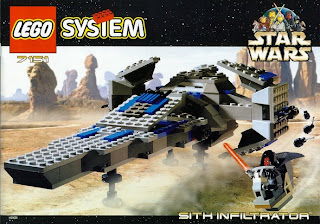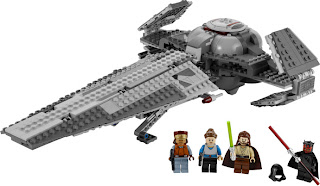As I have rebuilt I have seen how dramatically Lego's product line has changed in even the last 10 years (not to mention the last 30!). Look at the following two pictures, the first of which is the original Sith Infiltrator model from the first Episode 1 collection released concurrent with the movie in 1999 and the second is the most recent incarnation from this month (again July 2011 in the event that you are reading this well after the fact).
Side by side the first model looks like a bad joke, an ugly step sister or a maniacal scientist's inhumane experiment. Lego enthusiasts will use words like "blocky" or "non-streamlined" but no matter what term you use to describe it the fact of the matter is that the earlier version is far far inferior. Why? I can describe it in one word: realism.
Lego opened a pandora's box when they dove headfirst into the world of licensing with the original Star Wars collection in 1999. Whereas before Lego had always invented their worlds from scratch, they now had to depict vehicles, buildings and locations that people had seen in vivid, movie magic detail. No one had seen an M-Tron or a ship from Ice Planet (for my younger readers those are some space subthemes from the very early 90s) so we had to accept whatever vision Lego presented to us. As a result Lego was free to manufacture only a few new types of pieces from year to year while the vast majority of sets could be constructed of the exact same pieces from theme to theme with Lego simply changing the colors that they loaded into the injection machines. The original pirate ship (1989's Black Seas Barracuda), aside from its hull pieces, cannons and windows (the few new pieces), is constructed of exactly the same pieces you see in its contemporary castle and space sets, just in different colors.
 |
| 1989's Black Seas Barracuda |
 |
| 1988's Black Monarch's Castle |
 |
| 1989's Mission Commander |
But with Star Wars and the flood of franchises that have followed (Harry Potter, Prince of Persia, Speed Racer, etc.) Lego has had to change their entire paradigm. In the old themes Lego created new products by releasing new subthemes. In the space genre for example you got a new "team" each year which would look completely different than its predecessor. Look at the following pictures. The first is from the Ice Planet theme and the second is from the Space Police II theme.

Only a year separated these two themes yet they look completely different despite being made up of many of the exact same pieces. What was the advantage of this to Lego? Simple: making the majority of all their sets out of the same repertoire of pieces year after year kept manufacturing costs to a minimum. New pieces mean thousands of new molds which cost money to produce. When only a few new pieces were created a year these costs were kept to a minimum. The price we paid was unrealistic construction and sets that are, by today's standards, crude. But the benefit was that $30.00 could buy a set that now costs $70.00 (the respective costs of those two Sith Infiltrators I mentioned earlier).
Licensing has created a paradigm shift. When creating all their worlds from scratch Lego has infinite possibilities, new sets and themes are only a good idea away. But with licensing the designers are bound by the world already created for them, the only way to keep up a successful theme (like Star Wars) for more than the few years it takes to cycle through all the well known vehicles and locations available is to release multiple versions of the same thing. How do you keep up interest? Well the market (us) has spoken and we have told them, it is the same word I mentioned earlier: realism. Each successive offering must be more realistic than the last. First it was the ships and buildings, then the minifigures and now it is both. Lego has listened to us and given us exactly what we said we wanted, realism. The price we pay is first the licensing fees and secondly the cost to make all the molds for those realistic pieces, from Luke Skywalker's custom hair to a modular roof. At first it was just the licensed themes but the same philosophy has now bled out into every corner of the product line. Before a set's primary draw was its size and complexity. Now its realism and minifigures are meant to entice the buyers. It has been out with the big and crude and in with the small and exquisitely detailed. Old sets had lots of big pieces, new sets have lots of little ones. Old sets had massive baseplates to make them bigger and taller, new ones are built on a ring of 2x8 plates. Old sets required say a repertoire of 5000 pieces and 1000 molding machines to make all of them, now it takes 10,000 pieces (and the money it took to make all their molds) and 3000 molding machines (which have to be purchased and maintained). Old minifigures were a crudely painted guy with at best a beard, new minifigures have custom faces, torsos painted on the front and back, exclusive headgear, accessories and more. I am sure you are getting the picture.
Is this a good shift? Well the market seems to indicate yes. Lego is doing well corporately and there is a huge demand for the exclusive minifigures and other pieces that are coming in the new sets. This was driven home for me in a recent Bricklink purchase in which I acquired 7189 Mill Village Raid for $30.00, over 50% off, just because I was willing to buy it without the figures and animals it came with. That means that someone who purchased it at the full $70.00 was able to make enough on 6 figures and several animals to make it worth his while to offload 95% of the set's contents for less than half of what he paid. That tells me that, like the new prices or not, we asked for this paradigm shift.
Are Legos more expensive now than they were even 5 years ago? Without a doubt yes but there is a reason for it, and I do not think that reason is corporate greed. I think that we asked Lego to make their products a certain way and that is exactly what they have done. We can't have our cake and eat it too unfortunately!



No comments:
Post a Comment